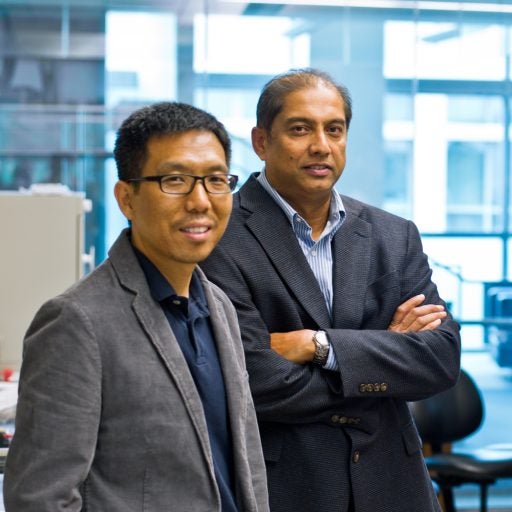Cancer patients may benefit from the research findings borne out of the first medical research collaborations between the University of Central Florida (UCF) and Sanford-Burnham Medical Research Institute at Lake Nona (Sanford-Burnham).
Two independent teams of cancer researchers, chemists, and bio-informatics engineers have published discoveries that may lead to new methods of diagnosis and treatment. One invention may someday replace biopsies with a new non-invasive technique to detect cancerous tumors, while another team has documented the role of specific microRNAs – small pieces of genetic material – in melanoma, a deadly skin cancer.
“These are exactly the kind of collaborations we knew Medical City would spark. Combining our complementary expertise allowed us to accomplish what we could not have achieved independently,” said Kevin Belfield, Ph.D., UCF chemistry professor.
Snapping Images of Malignant Tumors
The first breakthrough generated by a UCF/Sanford-Burnham collaboration comes from Belfield and Masanobu Komatsu, Ph.D., an associate professor and cancer researcher at Sanford-Burnham. Their research focuses on a non-invasive way to image tumors within deep tissue that one day might complement or replace traditional biopsies and perhaps even be used to treat breast, lung, ovarian, brain, kidney, colon, and endometrial cancers.
Belfield has been developing the technique, which uses near-infrared light to look deep into cells, for years. He’s created a probe that looks for specific proteins that are linked to a variety of diseases. The probe also carries a fluorescent dye that lights up when observed with a special kind of microscope with near-infrared light. The technique is non-invasive and has had promising results, but Belfield wanted to test the technique in more than cells or tissue slices on slides. Komatsu’s research provided the biological system to advance his invention.
Their partnership began in 2008 when Belfield heard Komatsu present at a Sanford-Burnham weekly scientific seminar series. Komatsu is a biologist who studies the regulation of blood vessel growth in tumors at the molecular level. His goal is to modify the abnormal development of vessels so that medicine can reach the tumor while not over-feeding it with nutrients and stimulating growth. The two scientists spoke, realized that their expertise was complementary, and began a partnership that recently resulted in publication of their studies in Bioconjugate Chemistry, a highly cited journal.
Belfield tweaked the chemical probe to specifically bind to folate receptors, which are present in certain kinds of cancerous tumors, particularly cervical cancer. This special mix of non-toxic dyes showed the tumor’s structure, including blood vessels and cells in the deep tissue. Komatsu, who has long been investigating malignant tumors and how they develop, tested the probe in mice.
“When administered, the probes specifically homed to the tumors,” Komatsu said. “This tumor-targeting technology and unique physical properties of the nanoparticles provides high-resolution, 3-D images of the tumors.”
The probes’ ability to define tumor structure is significant as it may help to diagnose a person’s stage of cancer and enhance the effectiveness of treatment. While the probes carry fluorescent dyes now, they could also easily carry therapeutic drugs, Belfield said.
Understanding Melanoma Cancer on the Molecular Level
The second partnership evolved from the research of Ranjan Perera, Ph.D., an associate professor at Sanford-Burnham. He has been investigating the role of microRNAs – small pieces of genetic material – in melanoma for several years.
Perera and his team of biologists operate a state-of-the-art genome sequencing laboratory to compare patterns of microRNAs and their target gene expression in melanoma cells and normal melanocytes in hopes of finding differences that could be targeted for new diagnostics or therapeutics.
Their research found that melanocyte growth and the cancer’s ability to invade other tissue is partially controlled by abnormal expression of microRNAs. “We’ve identified two specific microRNAs, called miR-375 and miR-34b, which could be used not only as novel diagnostic markers for early melanoma detection, but may also serve as therapeutic targets,” explained Perera.
Because the team looked at so many different cells and patient samples, they generated a lot of data through next-generation sequencing technology that needed to be annotated and interpreted. Perera set out to find someone with the expertise and computing power to help him analyze the data. That’s when he met Shaojie Zhang, Ph.D., an assistant professor of engineering and computer science at UCF, whose expertise is in bioinformatics. Dr. Zhang and his graduate students analyzed the data using a computer program to identify differences in gene expression and methylation patterns between healthy and diseased cells.
The team’s findings were recently published in the scientific journals FEBS Letters and PLoS ONE. A third paper is in the works.
“The collaboration between genomics and bioinformatics, two of the most advanced technologies in biomedical research, empowered this important research. These discoveries offer the possibility that the microRNAs we identified could be used as biomarkers to assist in earlier diagnoses of this fatal cancer,” Perera said.
For Zhang, the partnership has also meant an opportunity to give his graduate students real-world experience. “The collaboration provides an interdisciplinary education opportunity to the graduate students from the College of Engineering and Computer Science who are interested in applying their computational skills to biomedical research,” Zhang said. “The partnership not only helps advance science, but it also helps train future scientists. I’m very pleased to be a part of it.”
While both teams are still years away from creating FDA-approved products that will benefit patients, the union of expertise between disciplines and institutions is certainly speeding up the research process. That means patients may see results faster.
